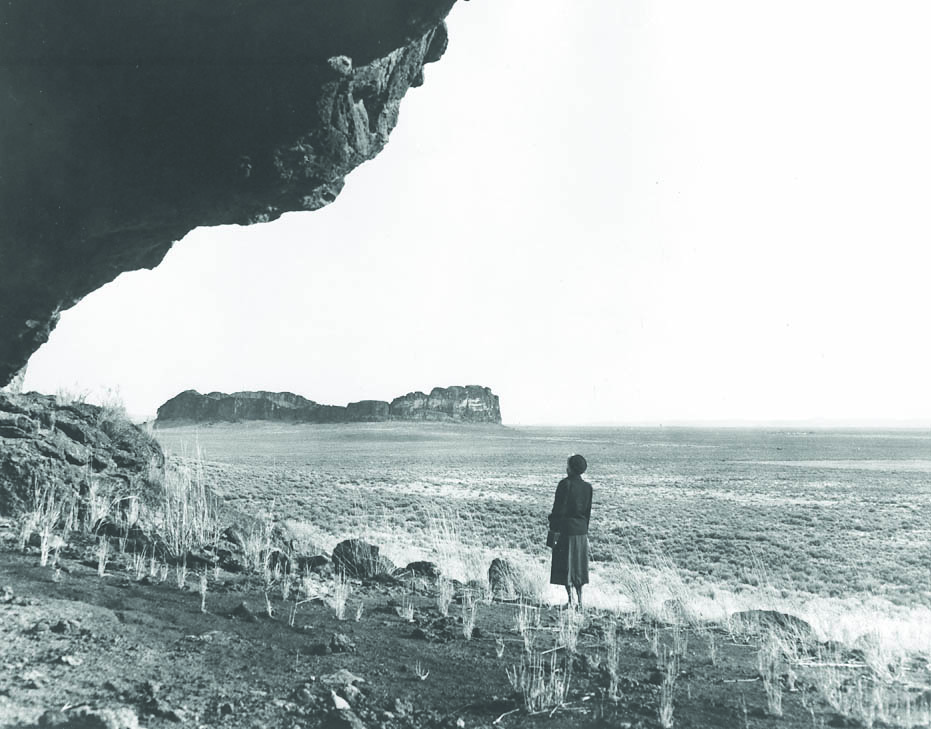The Paisley Caves—more formally known as Paisley Five Mile Caves—in south-central Oregon are among the oldest archaeological deposits in North America. The seven creases that create the caves were etched into a low basalt ridge during the ice age by waves moving across Lake Chewaucan.
In the summers of 1938 and 1939, archaeologist Luther Cressman and a team of researchers from the University of Oregon were the first to excavate the caves. Cressman reported that he and his team had discovered direct evidence that Indigenous people had inhabited the site at the same time as extinct Pleistocene species such as camels, mastodons, and horses.
The manner of excavation and data recording in the late 1930s, however, as well as the limited understanding at the time of archaeological dating techniques and the potential of genetic analysis, later made the antiquity of the site questionable. At the time, archaeologists reached a consensus that the earliest inhabitants of the New World consisted of people who came to be known as the Clovis culture. The name was derived from the impressive stone spear points first discovered at a site in New Mexico and subsequently unearthed at sites throughout much of the continent, often in deposits with extinct mastodon.
Beginning in the summer of 2002, teams of archaeology students and researchers, under the supervision of Dennis L. Jenkins at the University of Oregon, resumed excavations of the Paisley Caves. The crews have been using state-of-the-art stratigraphic excavation techniques and laboratory analysis unimagined in Cressman’s era. Archaeologists at the site are identifying the successive deposits of soils, sands, and gravels and analyzing materials found associated with them separately. They focus on spatially locating every item within the caves relative to the research team's growing comprehension of events that marked the passage of time at the site. Cultural materials such as sage cordage and grass threads, obsidian and bone tool fragments, wooden pegs, cut animal bones, and evidence of fire hearths have been discovered in the caves intermingled with Pleistocene animal bones. Methods of radiocarbon dating unknown when the site was first probed by scientists now permit them to link such items to fairly precise moments in time.
Crucially, researchers also have identified and collected dozens of desiccated human feces—called coprolites. These humble items underwent examination by Eske Willerslev of the University of Copenhagen, who identified human mitochondrial DNA that was identical to that of the peoples already known to have first emigrated from Asia to the Americas. Evidence from these finds demonstrated that their diets consisted in part of grasses, sage grouse, and extinct giant bison. Furthermore, the coprolites produced multiple radiocarbon dates that calibrated to over 14,000 years before the present, predating the earliest Clovis sites by over a thousand years.
The first publication of these discoveries met with doubts and attempted refutations by many in the archaeological community. Researchers raised questions about the certainty that the coprolites were human, the problematic nature of excavating possibly jumbled cave deposits, and the potential for non-human coprolites to later be contaminated by human DNA.
Additional fieldwork under Jenkins’s supervision in 2007 and 2009 strengthened the case that the Paisley Caves represent an early and heretofore undiscovered settling of western North America. Most notably, researchers found a spectacular serrated bone tool that, when radiocarbon dated, reaffirmed the pre-Clovis origins of the human coprolites. Jenkins invited skeptics to an “archaeological summit” at the site in the fall of 2009, persuading several to accept his interpretation of the site. Most archaeologists now believe that the Paisley Five Mile Caves is one of the earliest and most important archaeological sites on the American continent.
-
![Luther Cressman speaking at Dedication of Fort Rock Cave historical landmark, June 1963.]()
Ft. Rock Cave, Cressman, Luther, at, bb004556.
Luther Cressman speaking at Dedication of Fort Rock Cave historical landmark, June 1963. Oreg. Hist. Soc. Research Lib., bb004556
Related Entries
-
![Fort Rock Cave]()
Fort Rock Cave
Fort Rock Cave is located in a small volcanic butte approximately half …
-
![Pleistocene Pluvial Lakes]()
Pleistocene Pluvial Lakes
During the Last Glacial Maximum, from about 24,000 to about 18,000 year…
Map This on the Oregon History WayFinder
The Oregon History Wayfinder is an interactive map that identifies significant places, people, and events in Oregon history.
Further Reading
Alt, David D. and Donald W. Hyndman. Roadside Geology of Oregon. Missoula, Mont.: Mountain Press Publishing, 1978.
Cressman, Luther S. The Sandal and the Cave: The Indians of Oregon. Corvallis: Oregon State University Press, 2005.
Cressman, Luther S.A. Golden Journey: Memoirs of an Archaeologist. Salt Lake City: University of Utah Press, 1988.
Jenkins, Dennis, et al. "Clovis Age Western Stemmed Projectile Points and Human Coprolites at the Paisley Caves." Science 337.6091 (July 13, 2012): 223-228.



